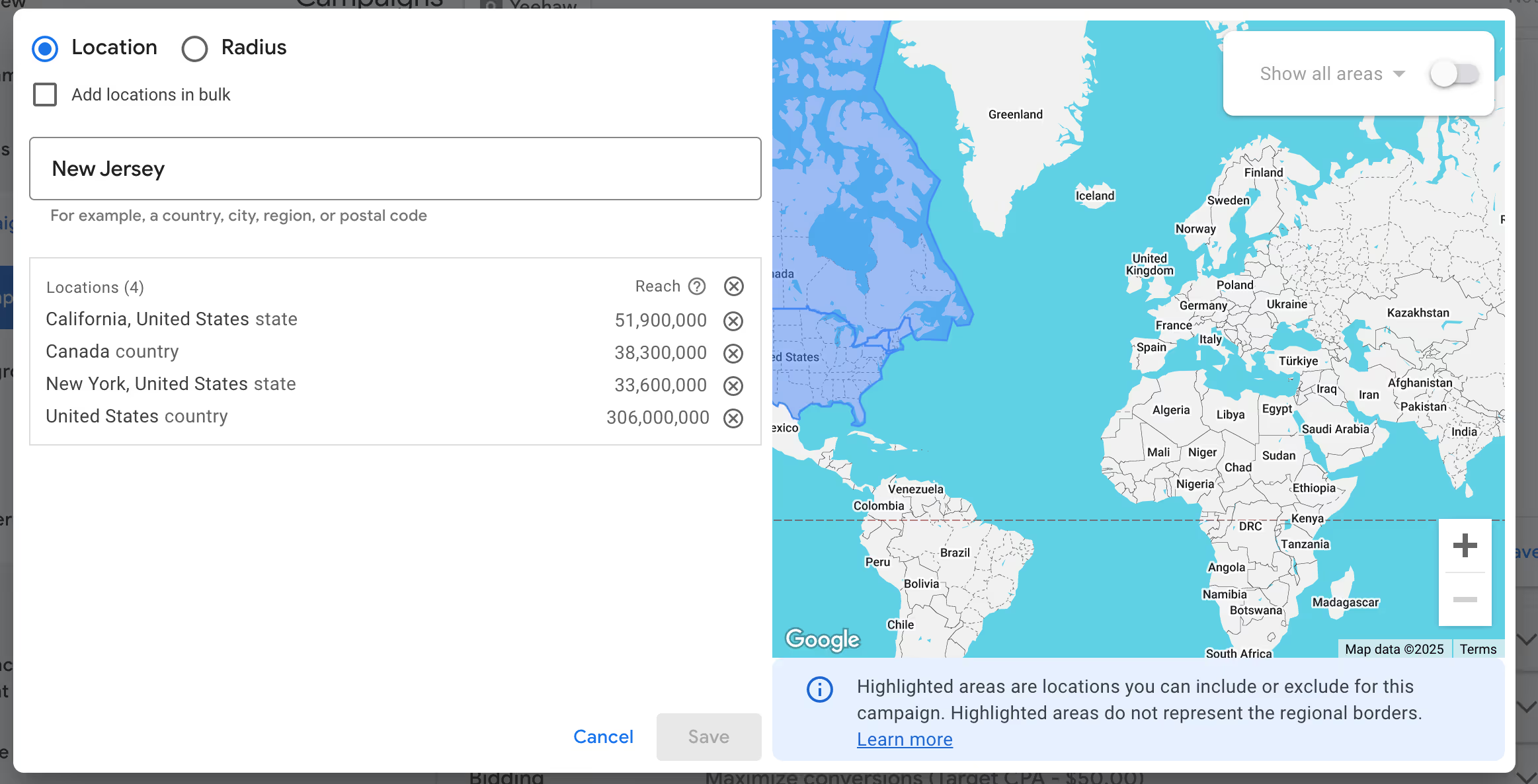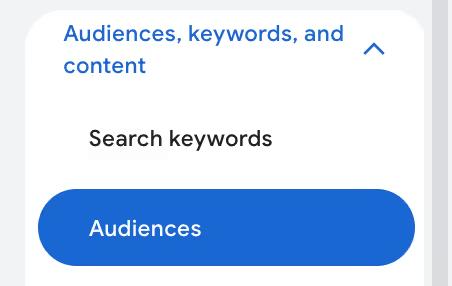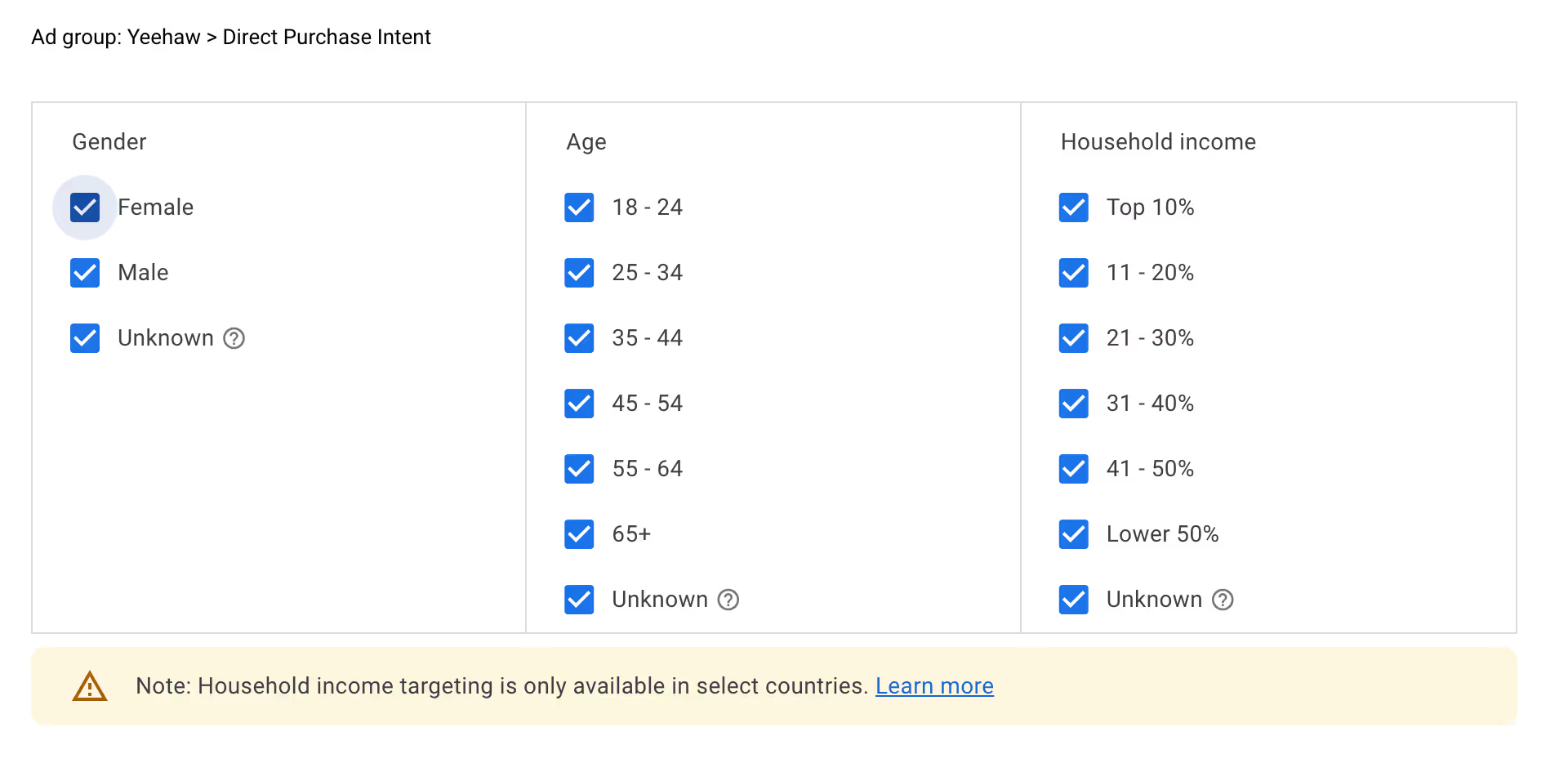
Conversation

Google Ads Targeting and Structuring
What you’ll learn
- The targeting options available for campaigns and ad groups, and how to use them effectively.
- Recommendations for structuring campaigns and ad groups to maximize performance.
Introduction
How you structure your Google Ads campaigns and ad groups depends on your:
- Keyword themes,
- Targeting goals, and
- Budget.
This lesson explores the targeting options available and provides a streamlined, modern approach for structuring your account—perfect for a startup testing Google Ads.
While targeting can feel complex, we’ll keep it simple and actionable for beginners.
Campaign Targeting
At the campaign level, you can target two primary options: locations and languages. These settings shape who sees your ads and are interconnected.
Locations
- Why it matters: Targeting the right locations ensures you reach potential customers while avoiding wasted spend on irrelevant areas.
- For ecom or local businesses: If you sell physical products or services in specific regions (e.g., the United States), target only those countries, states, or cities where you operate.
- See the bullet point below about "People In vs People Interested In"
- For SaaS or global products: If your product can be used worldwide (e.g., a $1,000/month SaaS tool), consider targeting “Tier 1” and “Tier 2” markets—major English-speaking countries (US, UK, Canada, Australia, New Zealand), Scandinavia (Sweden, Norway, Denmark), Western Europe (Germany, France, Netherlands), and parts of Eastern Asia (e.g., Singapore, Hong Kong). Avoid low-conversion regions like Latin America, Africa, India, etc, unless you have data showing viability.
- Targeting states and cities: If you're spending >$10k per month, you should target specific states, provinces, or major cities (e.g., US states, Canadian provinces, London, Paris) to analyze performance by region. Use Google Ads’ location reports to refine spending later.
- Do that by choosing Enter another location and adding them in separately.

- People In vs. People Interested In:
- Default: “Presence or interest” includes users in your target location or those showing interest (e.g., researching a trip or reading about the area).
- Recommendation: Set to “Presence: People in or regularly in your targeted locations” to target only people who are actually in that space, reducing irrelevant clicks. You’ll miss some travelers or unlocatable users, but this trade-off improves efficiency.

- Excluding locations: Exclude areas where you can’t or won’t serve (e.g., Alaska or Hawaii for a US-based product unavailable there). Use “People in your excluded locations” to avoid targeting researchers or travelers from those areas.
- To exclude, you need to do Enter another location then type the location and select Exclude

Languages
Language targeting is generally based on the language the user’s computer or browser is set to—not necessarily the languages they speak or understand.
This means Google targets users based on device or browser settings, which can sometimes lead to mismatches (e.g., a non-English speaker using an English browser might see English ads).
- Why it matters: Language targeting ensures your ads match users’ language preferences, improving relevance and conversions.
- Modern approach: Use “All languages” for high-English-fluency countries (e.g., US, UK, Canada, Australia, New Zealand, Netherlands, Sweden, Norway, Denmark) if your ads and landing pages are in English. Non-English speakers in these regions often use English fluently and convert well.
- For lower-English-fluency countries: Target only English (e.g., Germany, France, South Korea, Finland, Switzerland, Singapore, Hong Kong, Israel) unless you have multilingual ads and landing pages.
- To do that, you'll need to create a separate campaign from your main ones.
- Avoid overcomplicating: Don’t create separate campaigns for each language unless you have a very large budget and proven ROI from Google Ads—and if your site/product also tailors to that language. Google’s data shows English-only targeting performs well in high-fluency regions, simplifying management.
Campaign and Ad Group Targeting
Beyond campaigns, you can refine targeting at the ad group or campaign level with these options:
Audiences/Remarketing Lists
- Target specific audiences (e.g., website visitors, past customers, or in-market segments) to reach users more likely to convert.
- Use Google Ads’ audience suggestions (e.g., “Home & Garden” for landscaping services) or custom remarketing lists (e.g., users who visited your pricing page).
- You can either "target" or "observe" these audiences. We recommend setting it to Observe for now, which will let you see the relative performance. If one under- or over-performs, act accordingly.
- Keep it simple for beginners—start with broad in-market or affinity audiences, then refine based on performance.
Devices
- Target desktops, mobile phones, or tablets, but note: You can’t exclude devices entirely—you must adjust bids (e.g., “Decrease by 100%” to exclude
- Use device bid adjustments (e.g., +20% for mobile if conversions are higher) rather than strict exclusions. Google’s machine learning often handles device optimization effectively, especially with Smart Bidding (e.g., Target CPA or Maximize Conversions).

- You can’t target by operating system (e.g., iOS, Android) or browser, but address this in ad copy (e.g., “Download our iOS app now”).
- Oddly you get there by going Insights and reports then When and where ads showed
Ad Schedules
- Google automatically analyzes performance by day of the week and hour of day. Use this data to adjust bids for high-performing times (e.g., +20% during weekdays for B2B products).
- Avoid custom schedules unless you have clear data showing specific times outperform (e.g., work hours for B2B) or for whatever reason your product shouldn't be promoted at certain times. For startups, leave schedules open—intent-based searches can occur anytime, even at 3 a.m. on weekends.
Demographics (Gender, Age, Household Income)
In the Audiences, keywords, and content -> Audiences you can edit a few things including the demographics targeted on specific ad groups.


- Gender: Target “Female,” “Male,” or “Unknown” (e.g., untracked, minors, or non-binary users). Start broad (all genders) unless your product is clearly gender-specific (e.g., exclude men for feminine hygiene products). Optimize later based on data.
- Age: Target ranges like 18–24, 25–34, 35–44, 45–54, 55–64, 65+, or “Unknown.” For most products, focus on 25–54 (the “sweet spot” for spending power and tech adoption). Exclude 18–24 (low conversion rates) and 55+ (less likely to adopt new tech online) unless your product targets those groups.
- Household Income: Use categories like “Lower 50%,” “Top 41–50%,” etc. Start broad unless your product is niche or expensive (e.g., exclude “Lower 50%” for a luxury product). The 11–50% range often performs best for mass-market or mid-range products.
Campaign Structuring
Modern Google Ads structuring prioritizes simplicity, scalability, and Google’s automation.
Here’s how to structure campaigns and ad groups for a startup testing the channel:
Why create separate campaigns?
- Different budget needs: Separate campaigns for distinct goals (e.g., High Intent Searches, Problem-Solution Searches, Competitors) to control budgets independently. Google allocates your daily budget across a campaign’s ad groups, so splitting ensures no single keyword or location overspends (e.g., India dominating due to high volume).
- Unique targeting: Use separate campaigns for different locations, languages, or demographics if they require distinct strategies (e.g., US vs. UK, English vs. non-English regions). However, keep it simple for beginners—start with one campaign covering key markets.
- Testing strategies: Create separate campaigns to test bidding strategies (e.g., Target CPA for conversions, Maximize Clicks for traffic) or ad formats (e.g., RSAs vs. Performance Max).
Ad group structuring
- Tight themes: Group keywords by intent and theme within ad groups (e.g., “landscaping services,” “landscaper near me” for High Intent). Use 5–15 closely related keywords per ad group to maintain relevance and Quality Score.
- Avoid SKAGs: Single Keyword Ad Groups are an outdated thing. Modern accounts group broad match keywords into tight themes and use Responsive Search Ads, letting Google’s machine learning optimize dynamically.
Examples
You could either create one big campaign like we suggested earlier, or you can break the different ad group types into separate campaigns so you can have several ad groups and control the budgets.
That could look
- Campaign 1: Landscaping Services (High Intent)
- Ad Group 1: “Landscaping Services” (keywords: landscaping services, professional lawn care, yard maintenance).
- Ad Group 2: “Local Landscapers” (keywords: landscaper near me, local lawn care, nearby landscaping).
- Campaign 2: Problem-Solution Searches
- Ad Group 1: “Lawn Maintenance” (keywords: lawn maintenance services)
- Ad Group 2: "Fix Dying Lawn" (keywords: fix patchy lawn, lawn restoration services, green lawn tips).
- Campaign 3: Competitors
- Ad Group 1: “Competitor Alternatives” (keywords: better than [Competitor X], [Competitor X] alternative, eco-friendly landscaping).
Keeping it simple for startups
- Start with 1–2 campaigns covering your key markets (e.g., US, CA) and intent types (High Intent, Problem-Solution, Competitors).
- Target “All languages” or English in high-fluency regions and focus on key states/cities.
- Use broad demographics (25–54, all genders, 11–50% income—unless you target even more broadly than that) initially, narrowing based on data.
- Don’t split into dozens of campaigns upfront—test with either one campaign, or single campaign per intent type, then expand as you scale and prove ROI.
- Use Smart Bidding (e.g., Target CPA, Maximize Conversions) to let Google optimize bids dynamically across devices, times, and locations.
Okay, now with that, you understand the targeting options

